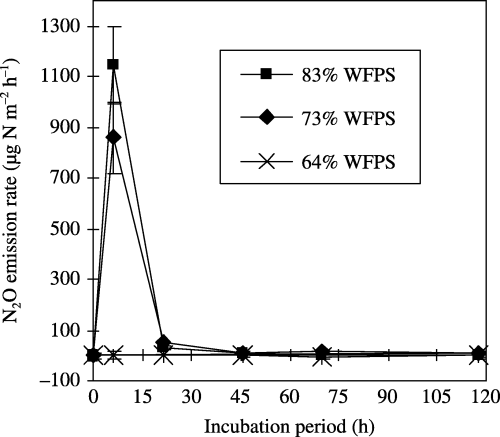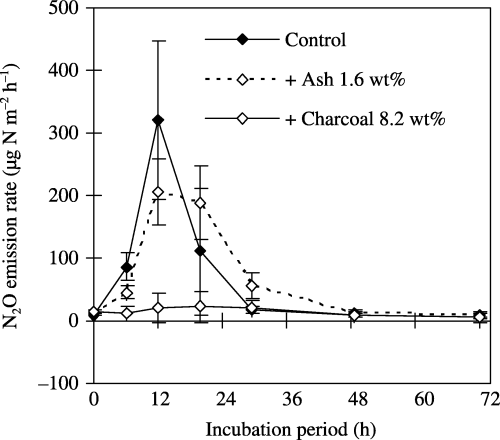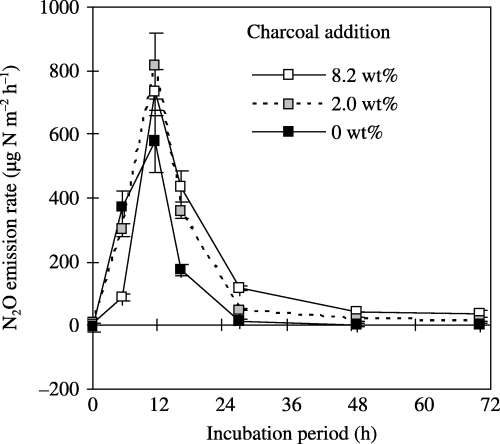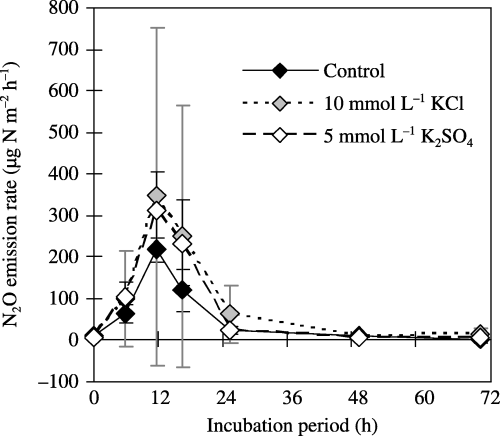Figures & data
Table 1 Selected physico-chemical properties of the air-dried soils examined in this study (oven-dry basis)
Table 2 Selected physico-chemical properties of charcoal and its ash examined in this study
Figure 1 Effect of rewetting on N2O emissions from soil (TG2005). An air-dried soil sample was rewetted using distilled water at 64 (×), 73 (⧫) and 83% (▪) of the water-filled pore space (WFPS) and incubated at room temperature. The values shown are the mean ± standard deviation of three replicates. The cumulative N2O emissions during the 120-h incubation period at a rewetting level of 64, 73 and 83% WFPS were −0.016 ± 0.082, 11 ± 1 and 13 ± 1 mg N m−2 (equivalent to −0.003 ± 0.03, 2.3 ± 0.3 and 2.8 ± 0.4 µg N g−1soil), respectively.

Figure 2 Effect of charcoal addition on N2O emissions from soil (TG2004) rewetted at 78% of the water-filled pore space of the soil. The values shown are the mean ± standard deviation of three replicates. The cumulative N2O emissions during the 168-h incubation period for the non-added control and the 10 wt% charcoal addition were 105 ± 14 and 11.1 ± 2.4 mg N m−2 (equivalent to 19.9 ± 2.7 and 2.1 ± 0.5 µg N g−1 soil), respectively.

Table 3 Estimation of Cl− and load onto soil (TG2005) by the addition of charcoal, ash and K solution
Figure 3 Effect of liming by using charcoal and its ash on N2O emissions from soil (TG2005) rewetted at 73% of its water-filled pore space. The values shown are the mean ± standard deviation of three replicates. The cumulative N2O emissions during the 72-h incubation period for the non-added control, ash-amended soil and charcoal-amended soil were 4.1 ± 1.9, 4.3 ± 1.2 and 0.8 ± 0.7 mg N m−2 (equivalent to 0.9 ± 0.4, 1.0 ± 0.3 and 0.2 ± 0.2 µg N g−1soil), respectively.

Figure 4 Effect of charcoal addition on N2O emissions from soil (TG2005) rewetted at 83% of its water-filled pore space. The values shown are the mean ± standard deviation of three replicates. The cumulative N2O emissions during the 72-h incubation period for the non-added control and the 2 and 8.2 wt% charcoal additions were 6.8 ± 0.9, 10.0 ± 0.8 and 10.3 ± 0.6 mg N m−2 (equivalent to 1.5 ± 0.2, 2.2 ± 0.2 and 2.4 ± 0.1 µg N g−1soil), respectively.

Figure 5 Effect of Cl− and of K salts on N2O emissions from soil (TG2005) rewetted at 73% of its water-filled pore space. An air-dried soil sample was rewetted using distilled water (control) or a K solution and incubated at room temperature. The values shown are the mean ± standard deviation of three replicates. The cumulative N2O emissions during the 72-h incubation period for the non-added control, the 10 mmol L−1 KCl-added soil and the 5 mmol L−1 K2SO4 added soil were 2.9 ± 0.6, 5.3 ± 6.1 and 4.4 ± 1.5 mg N m−2 (equivalent to 0.6 ± 0.1, 1.2 ± 1.3 and 1.0 ± 0.3 µg N g−1 soil), respectively.
